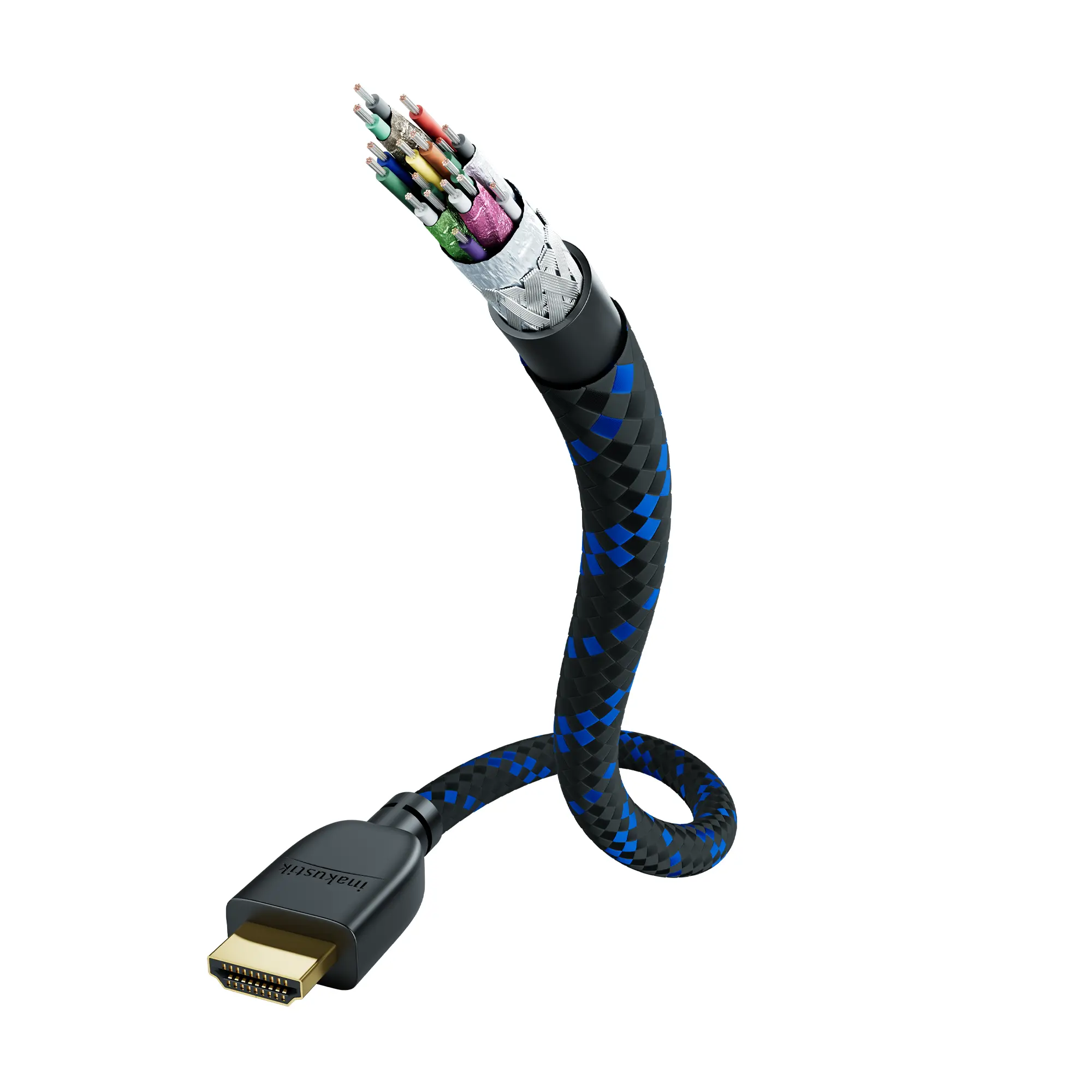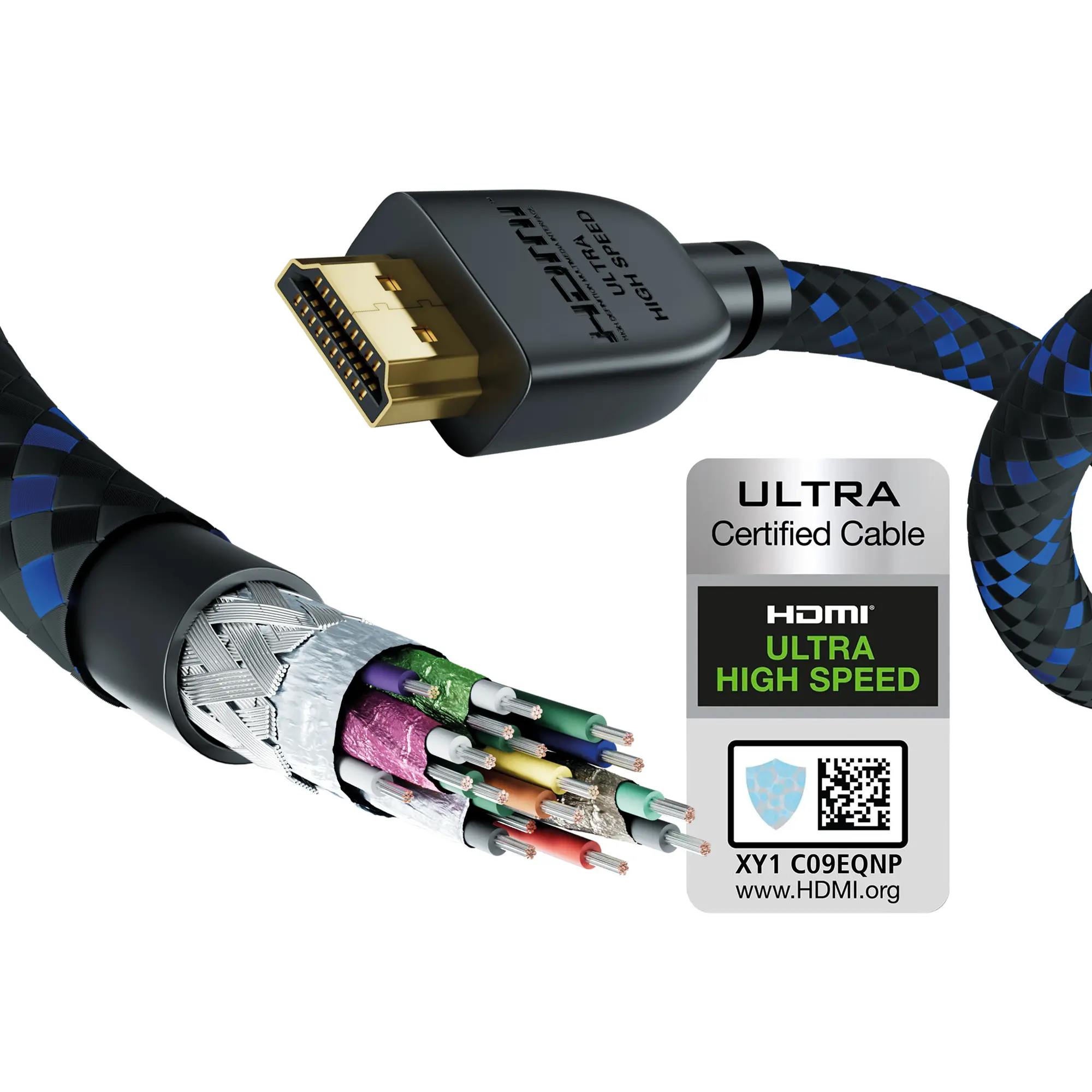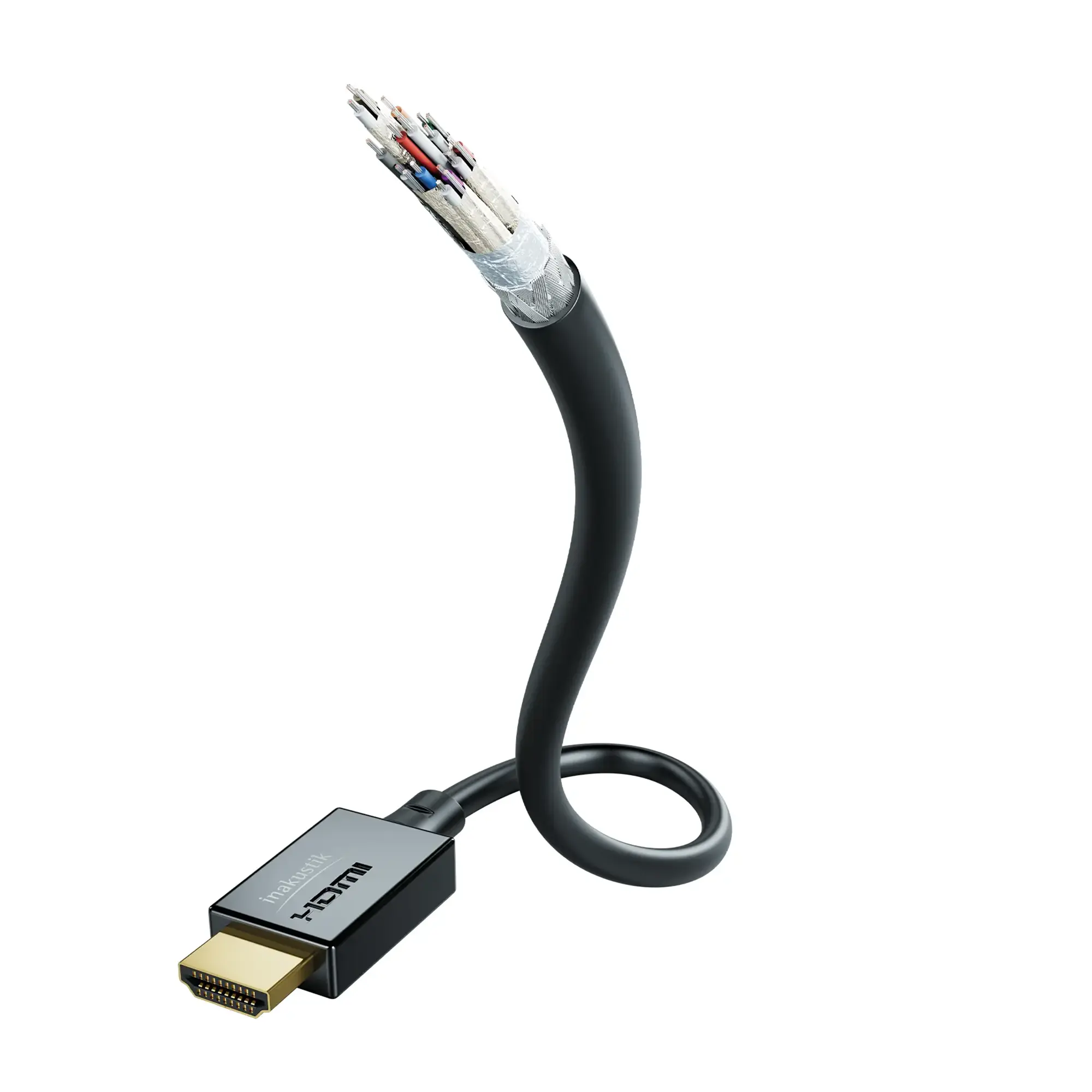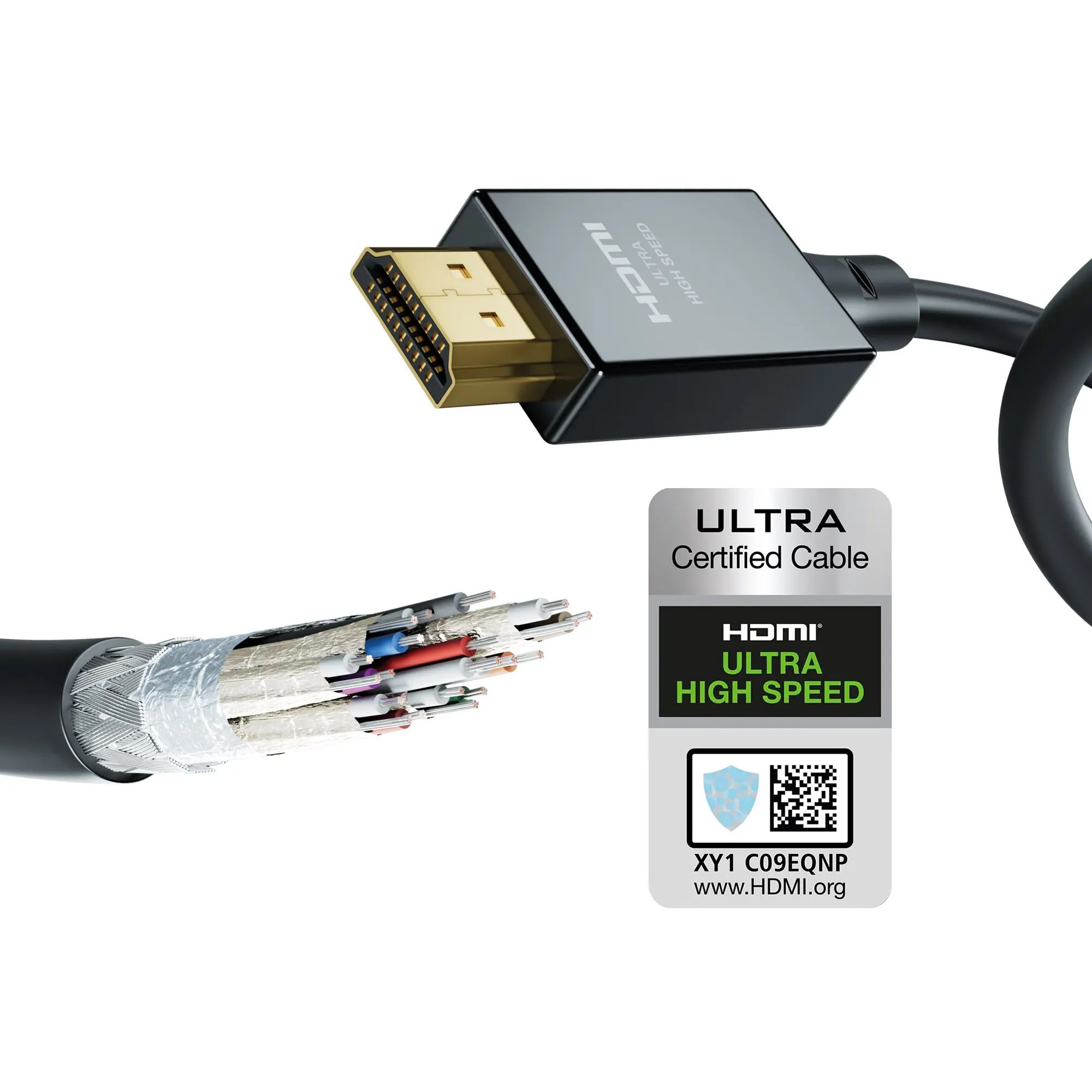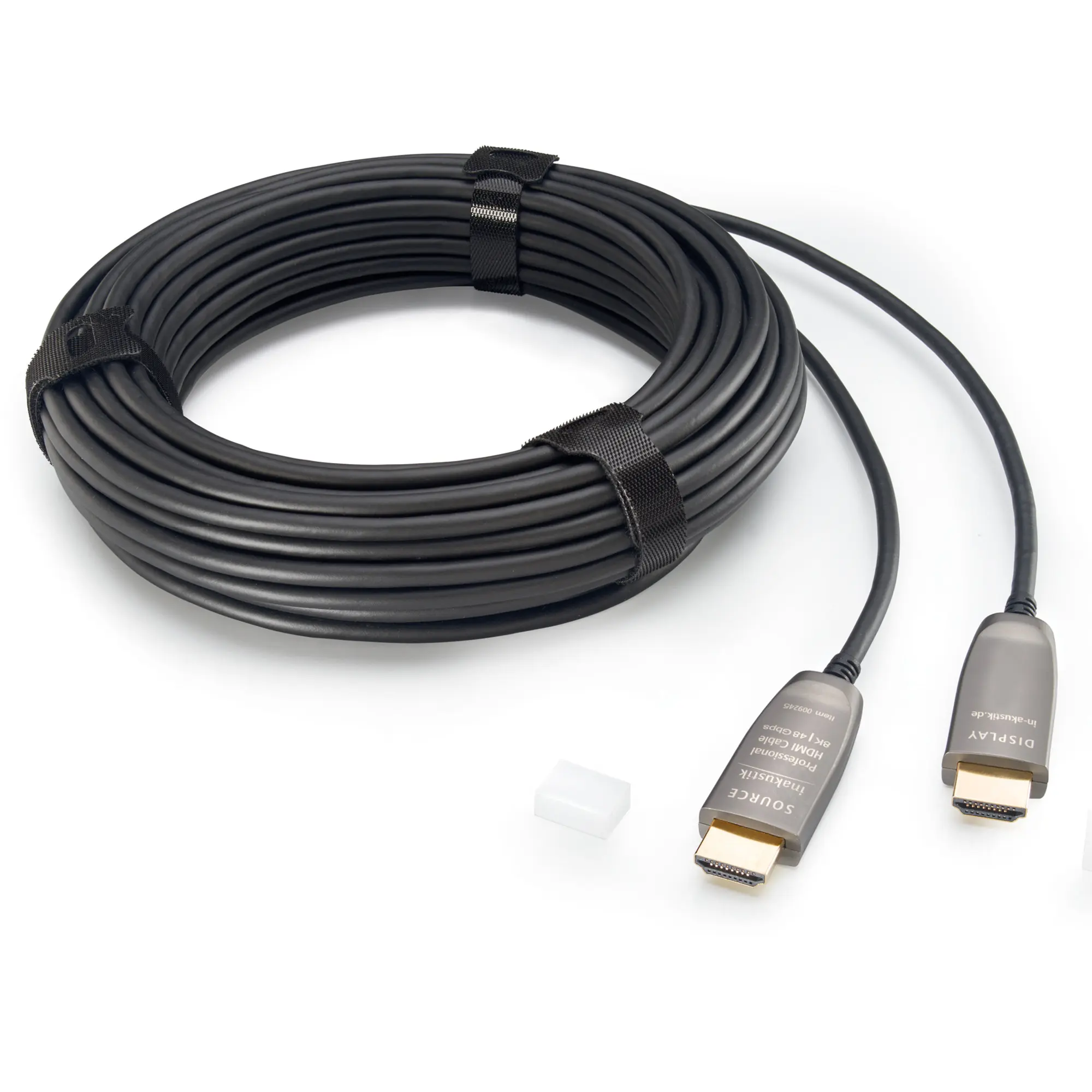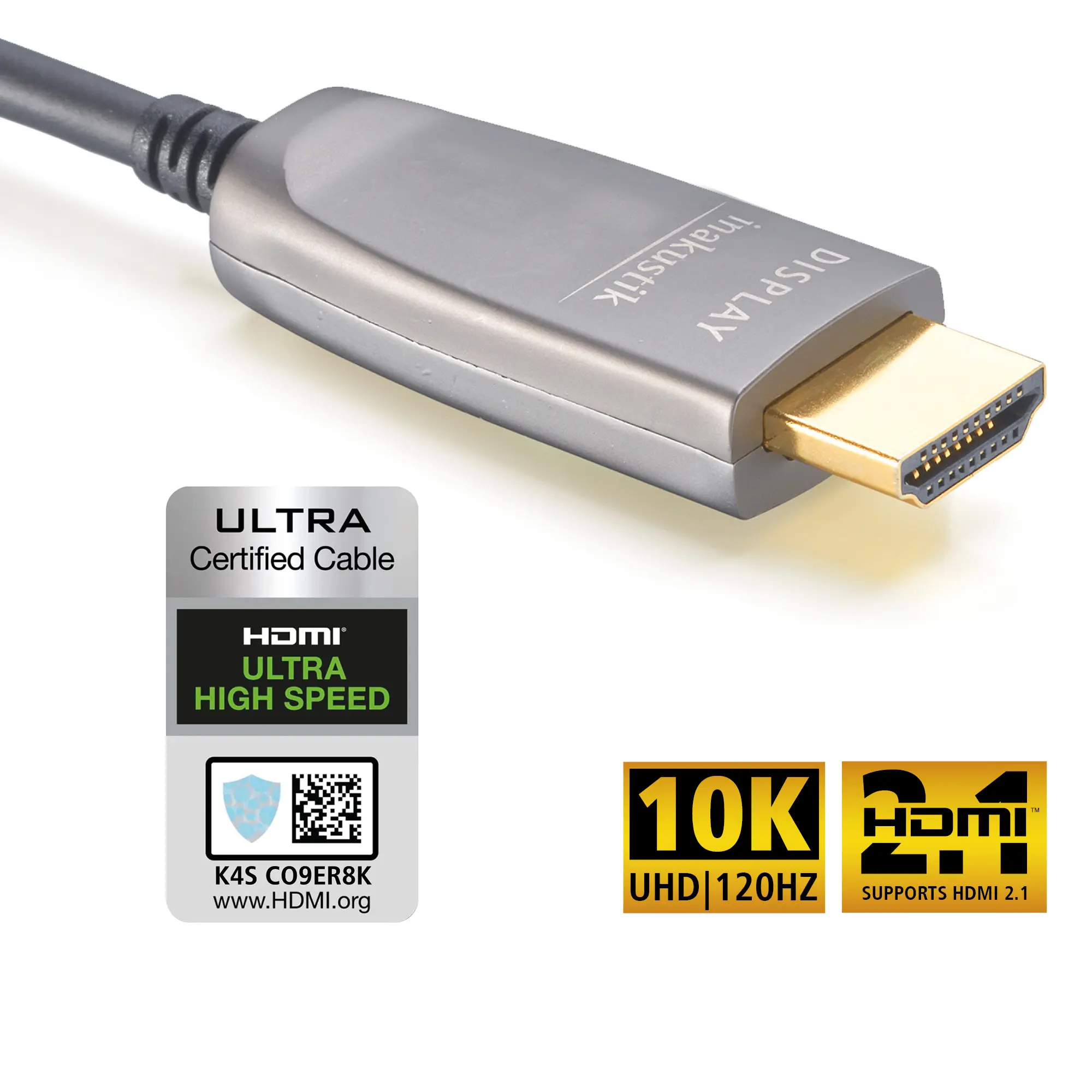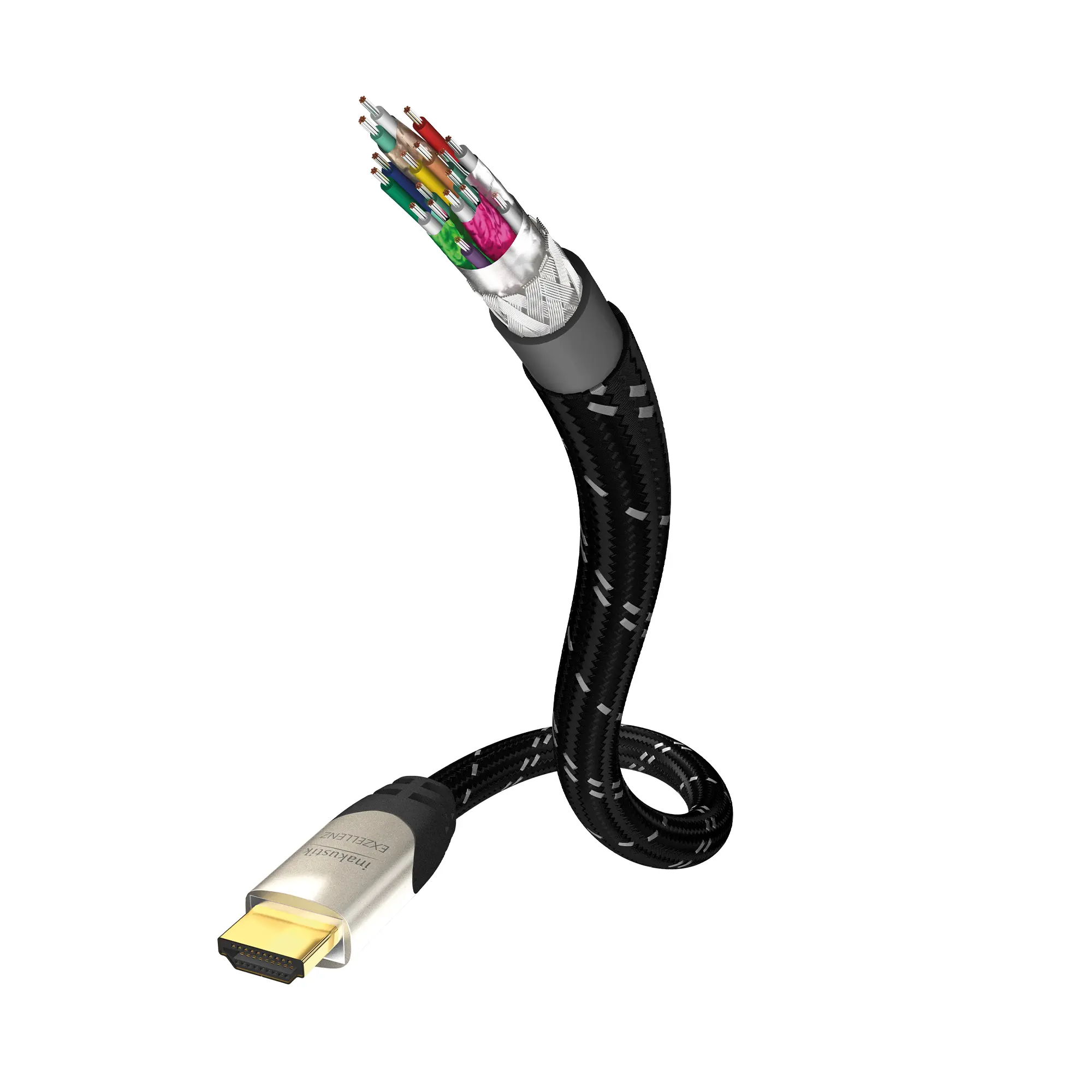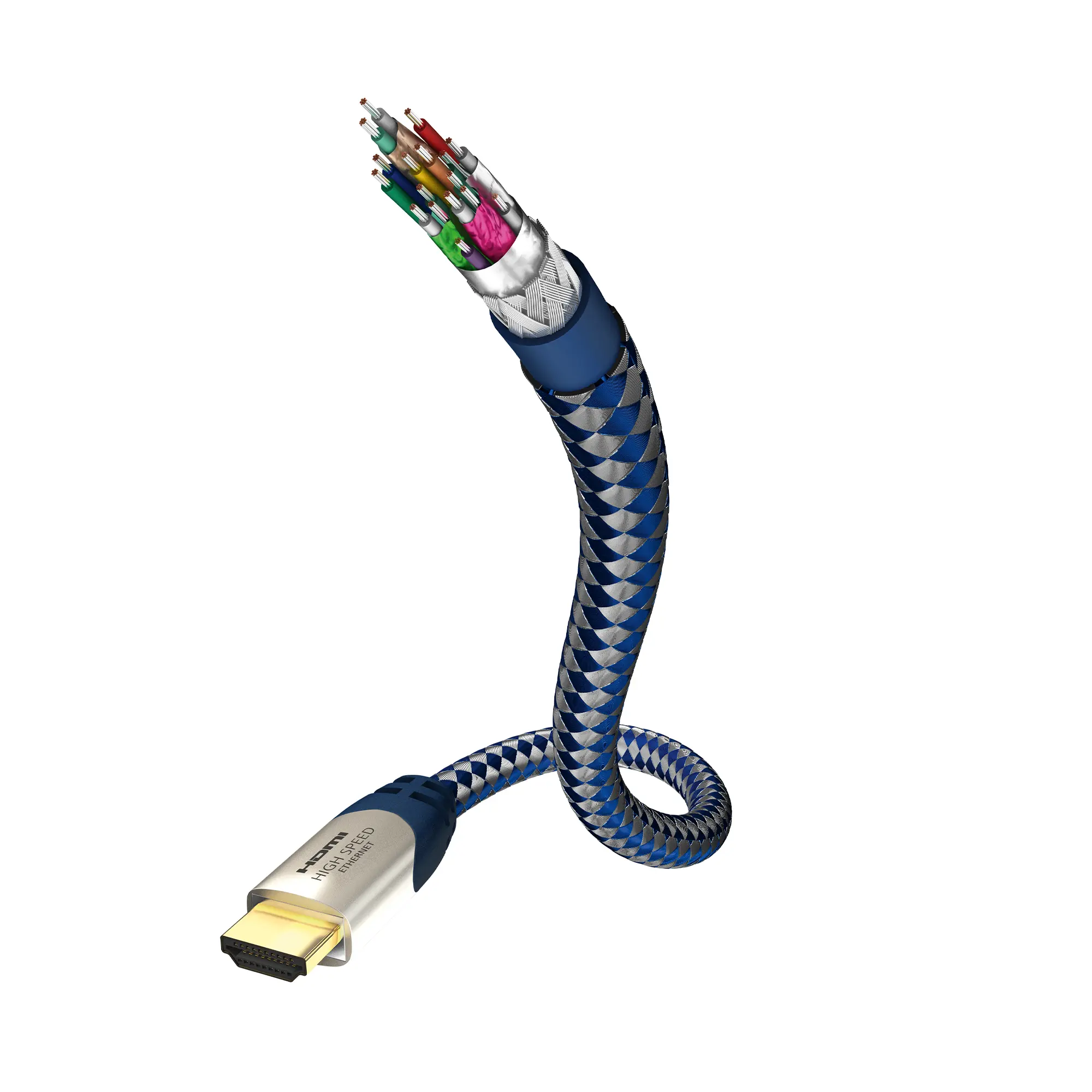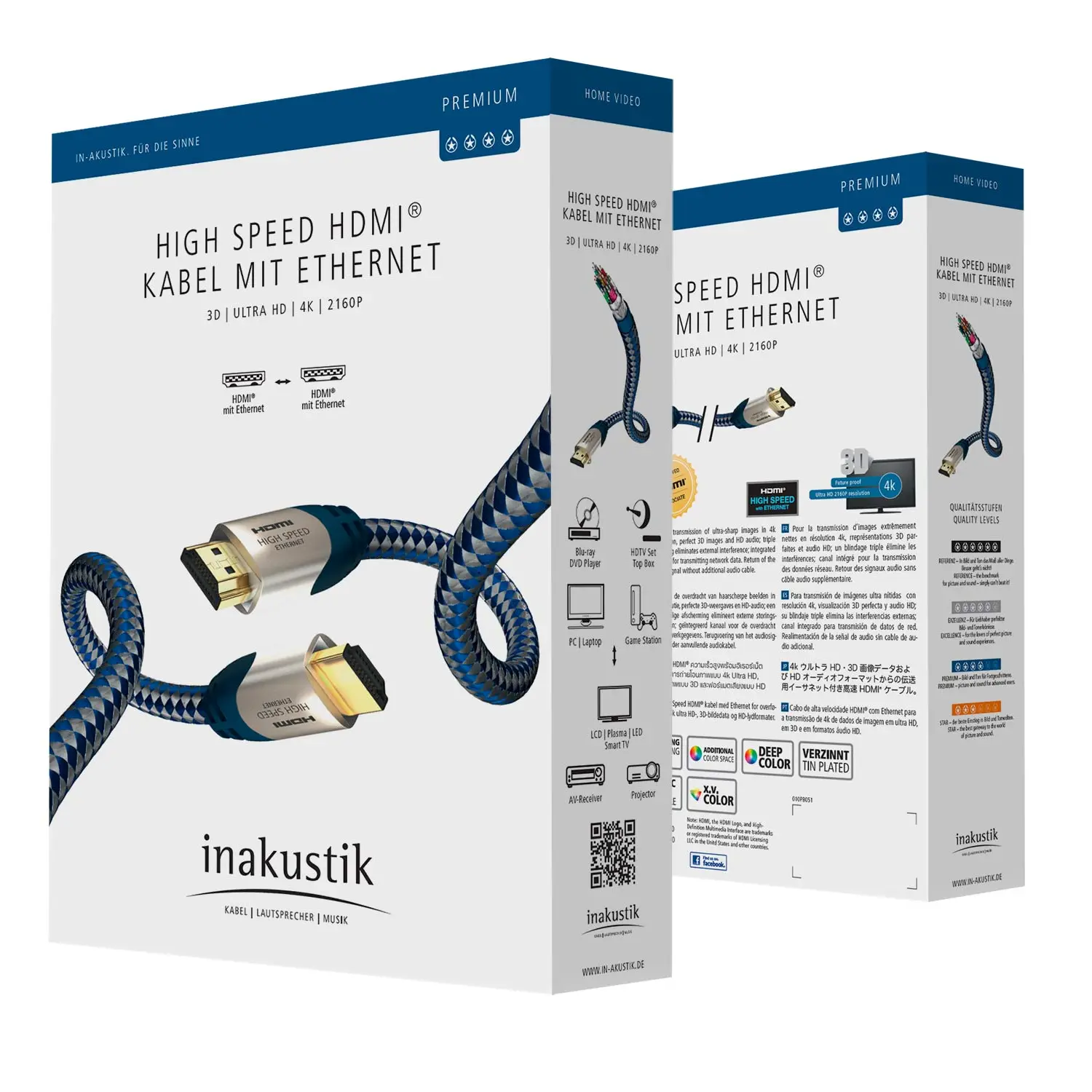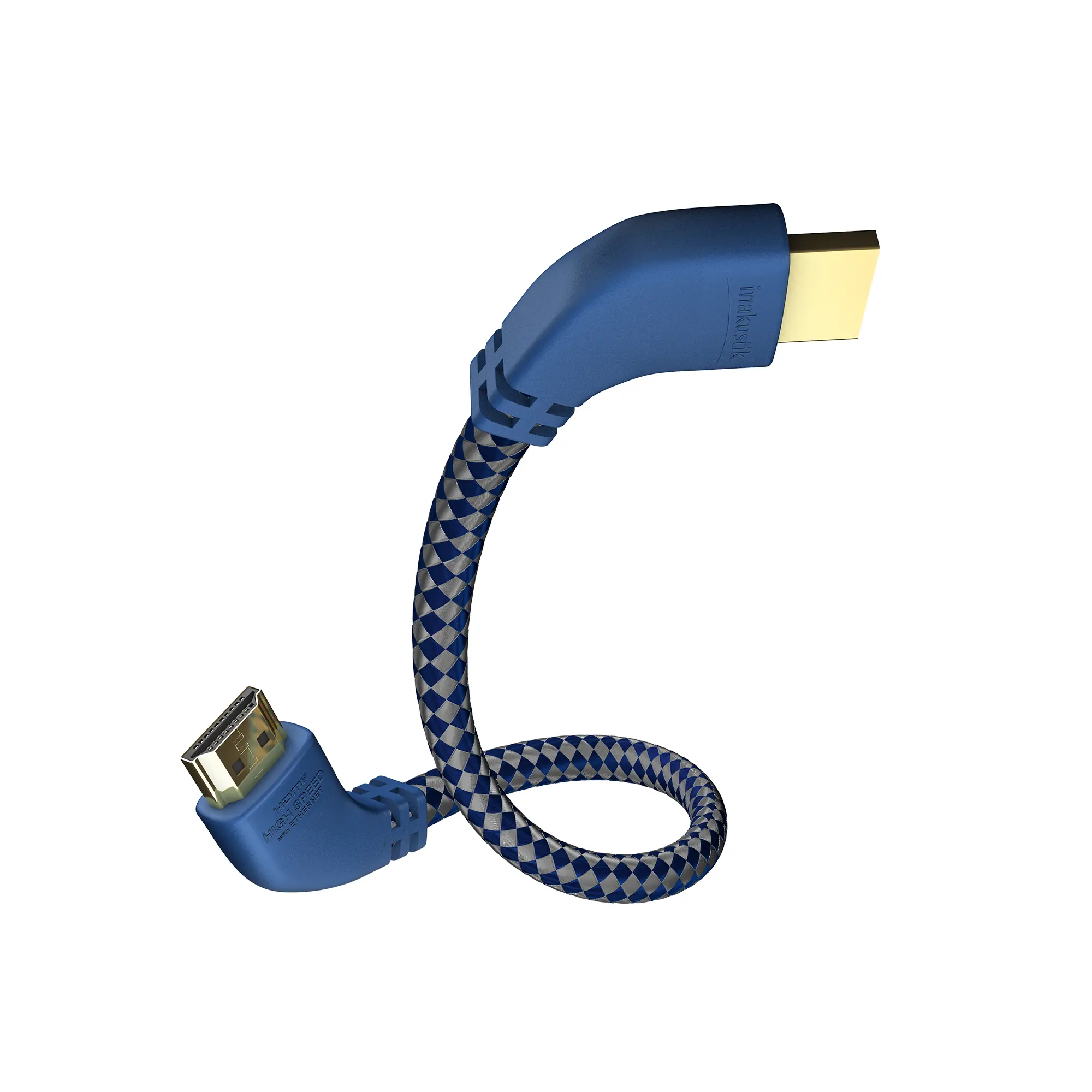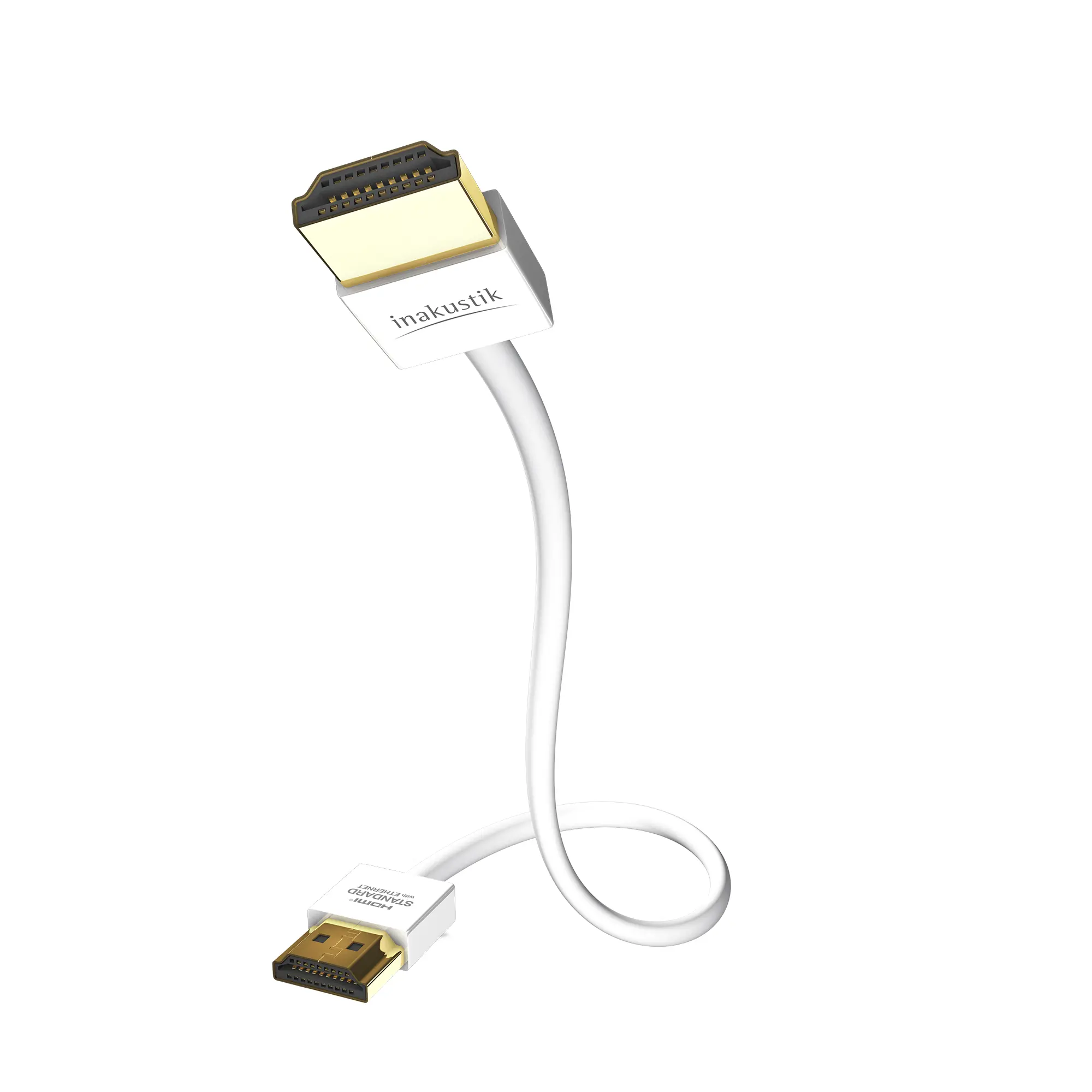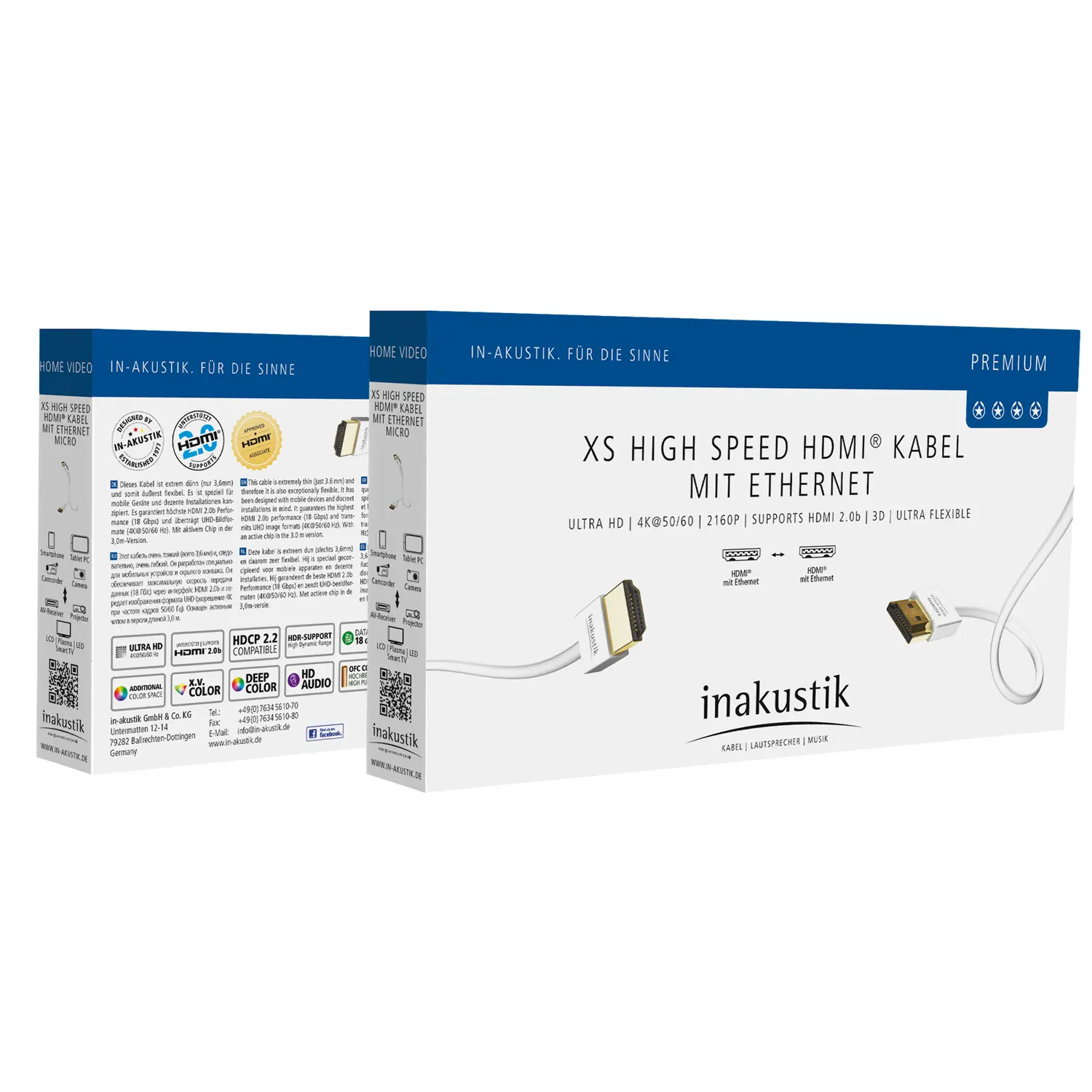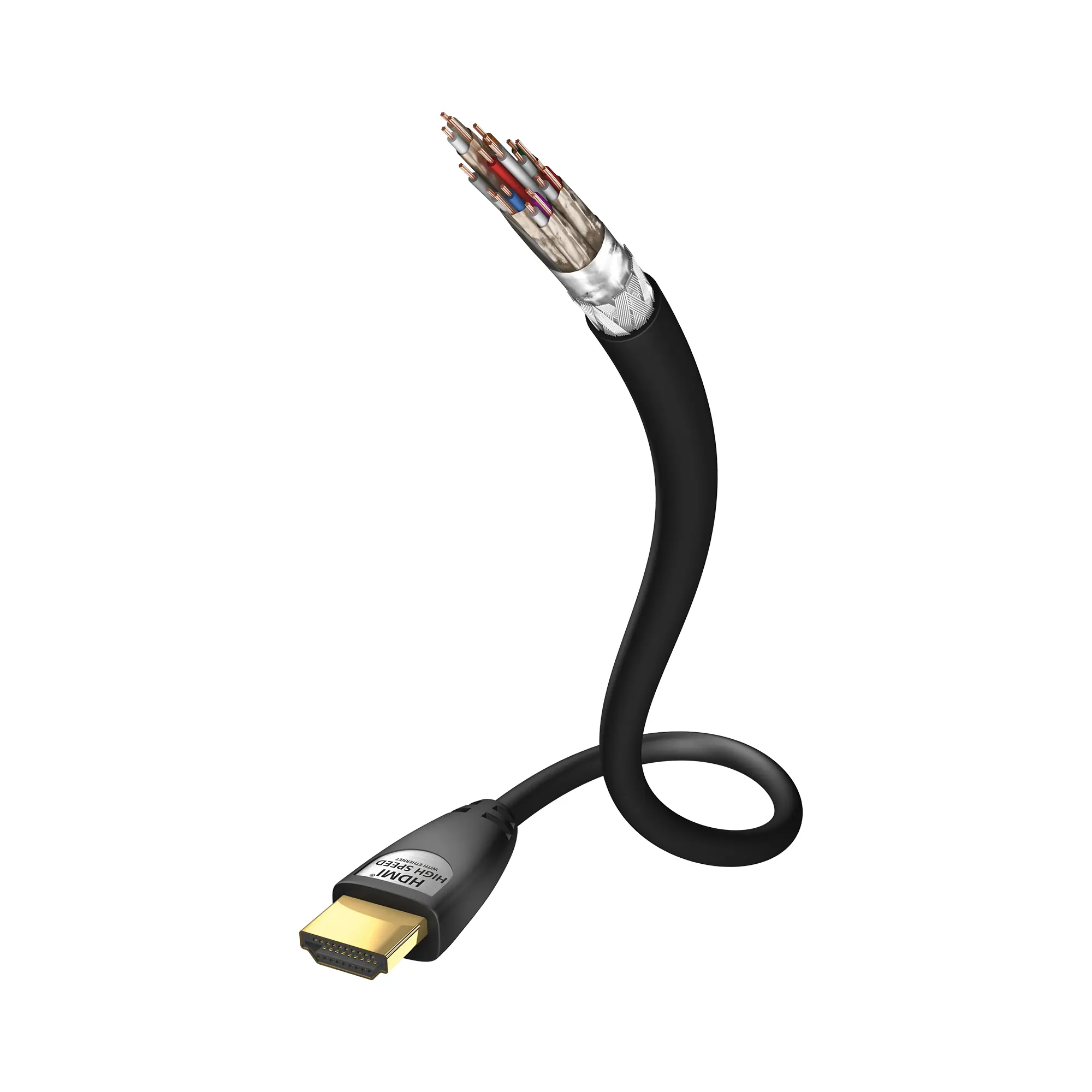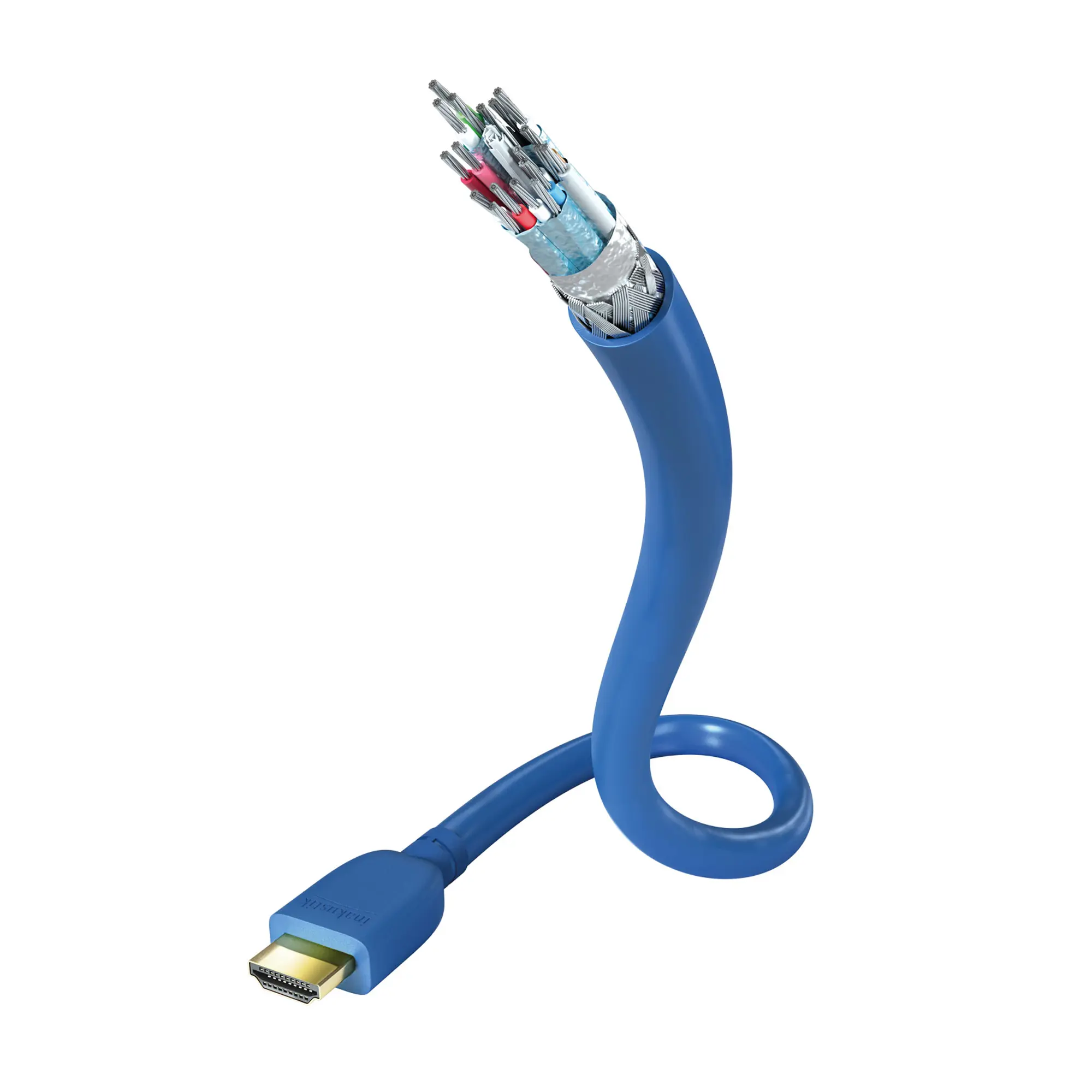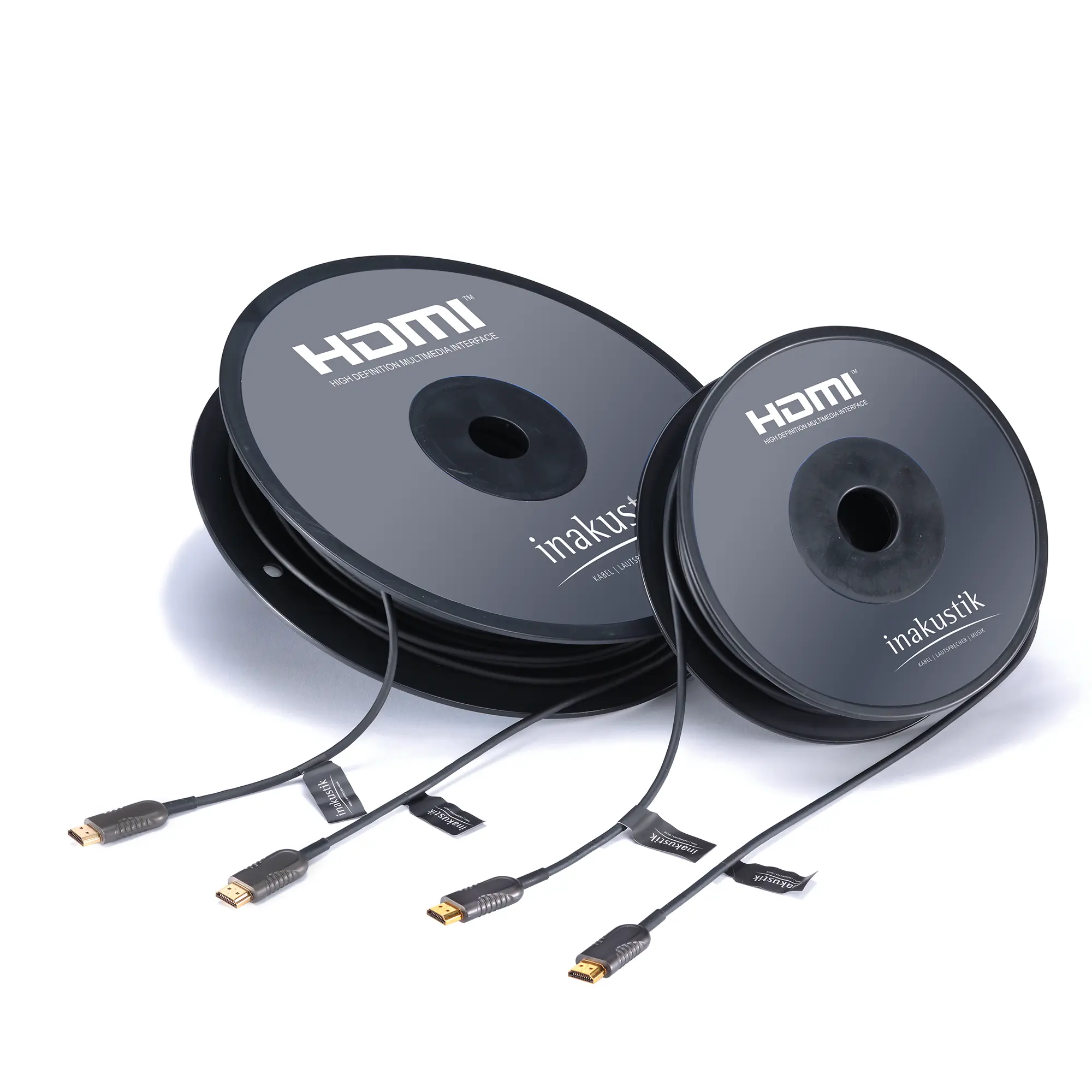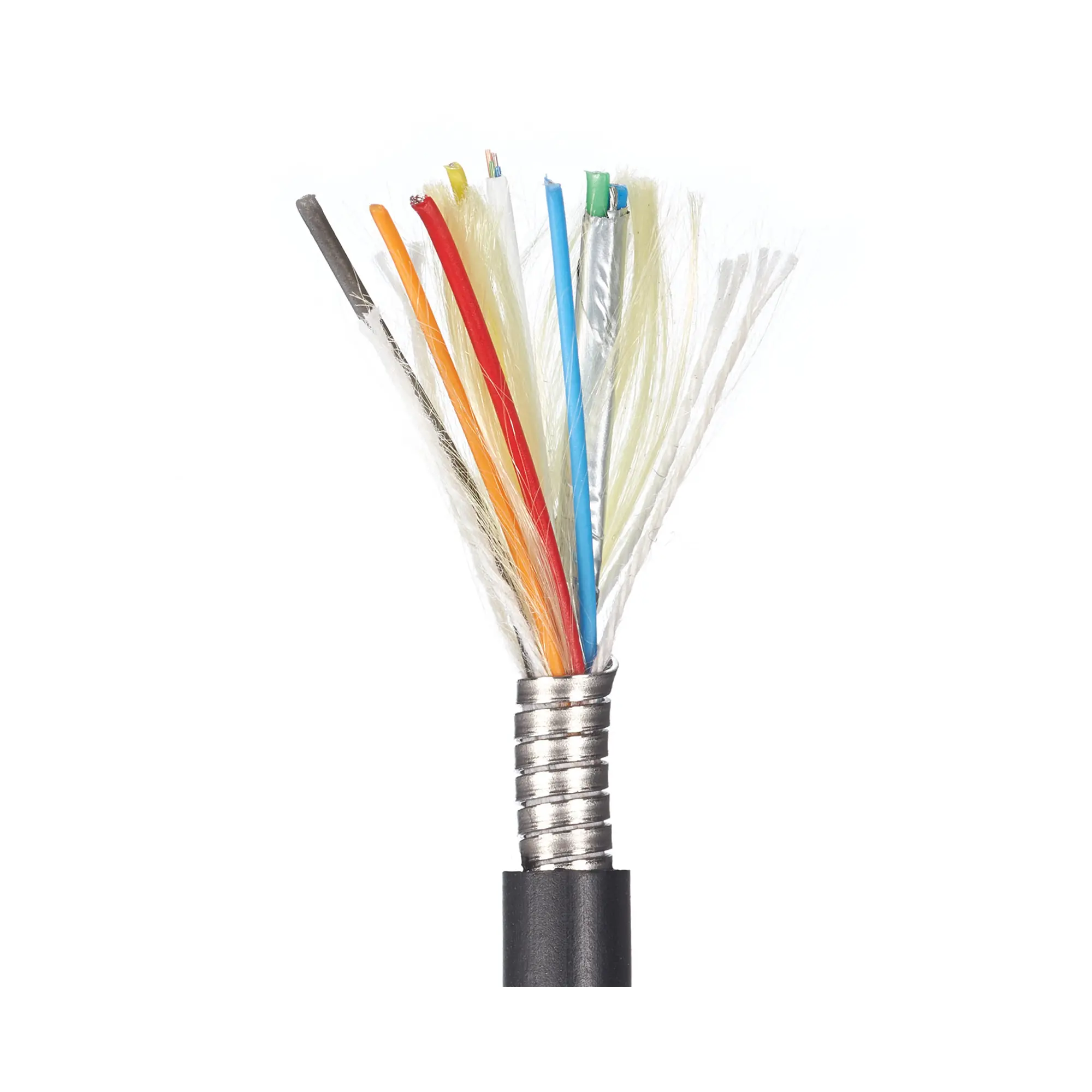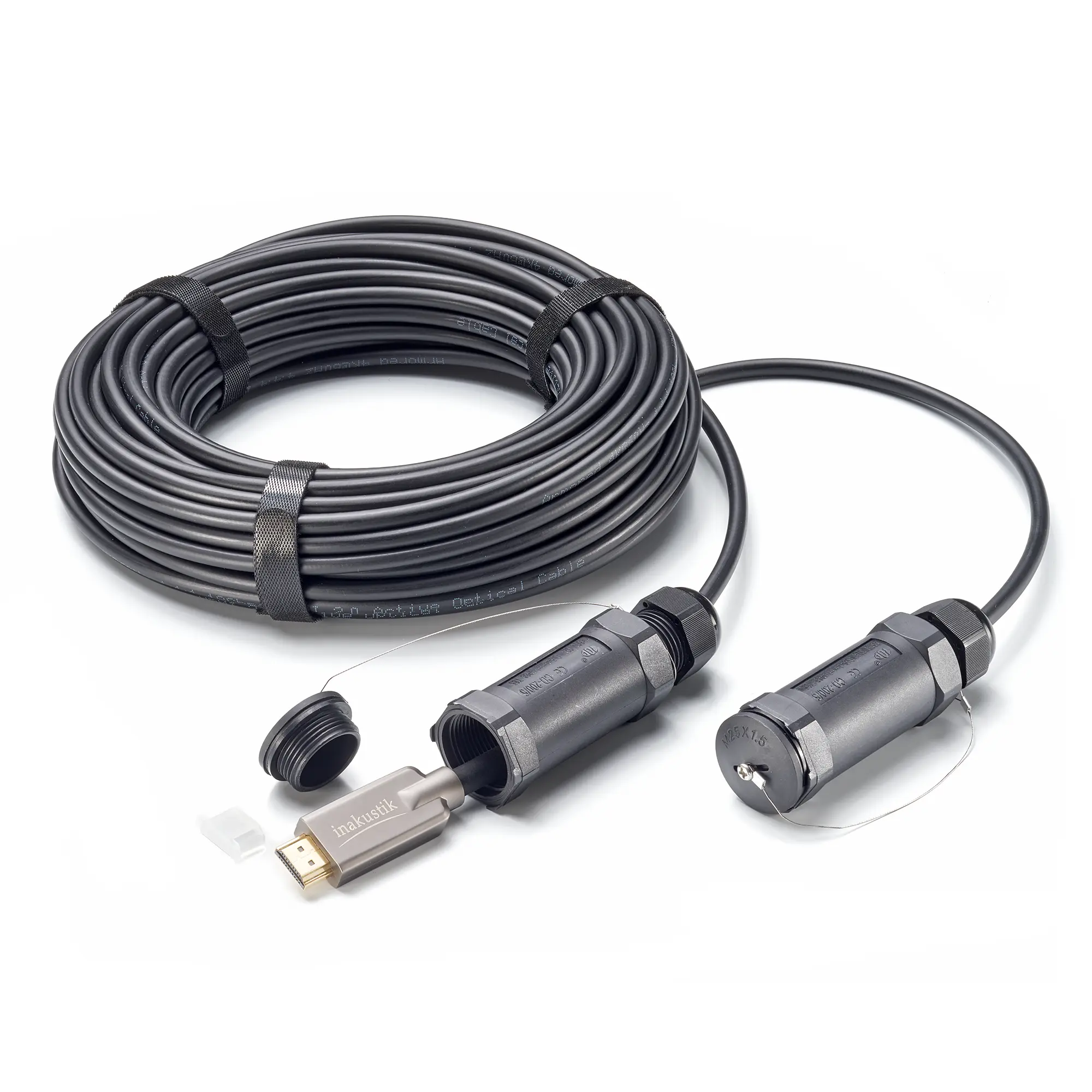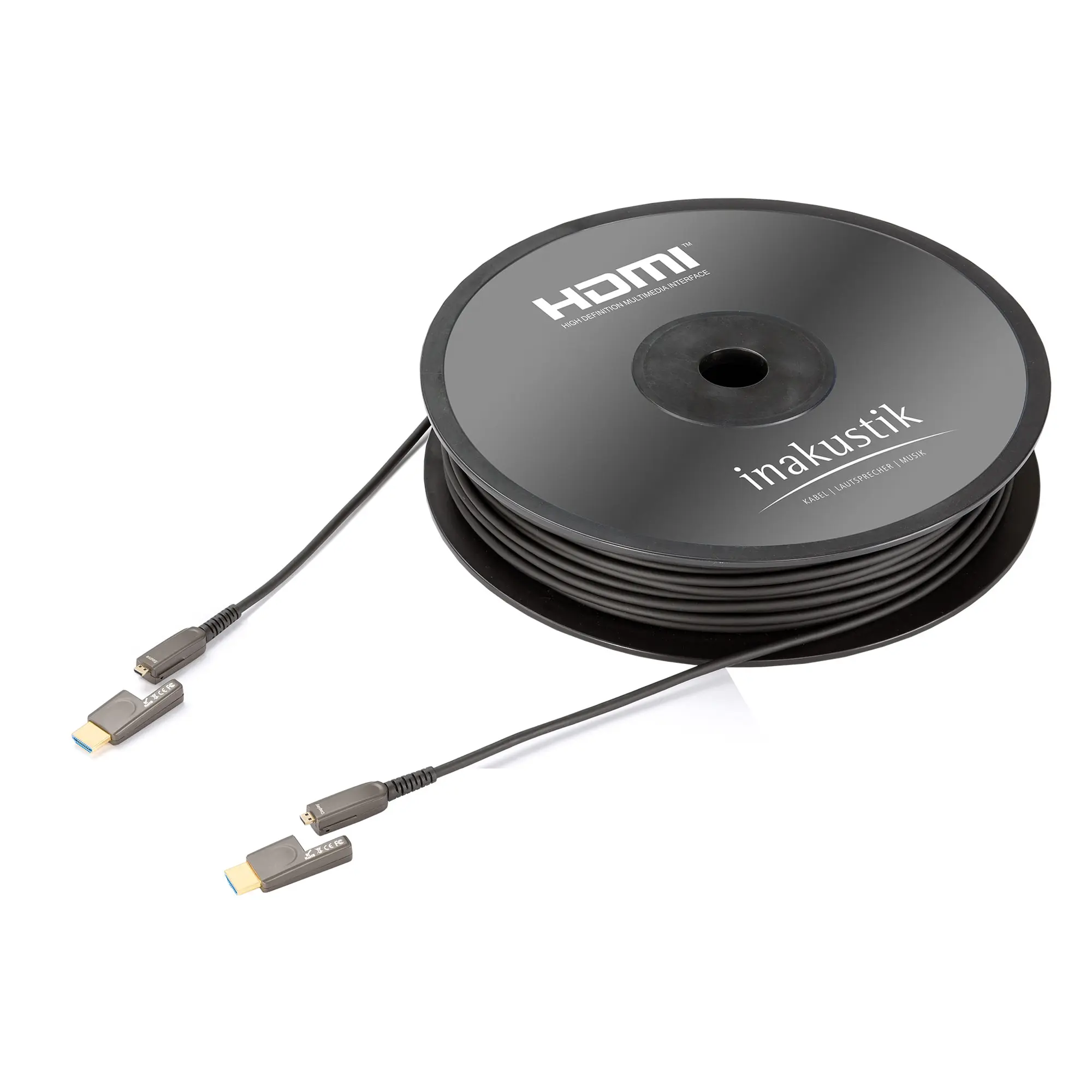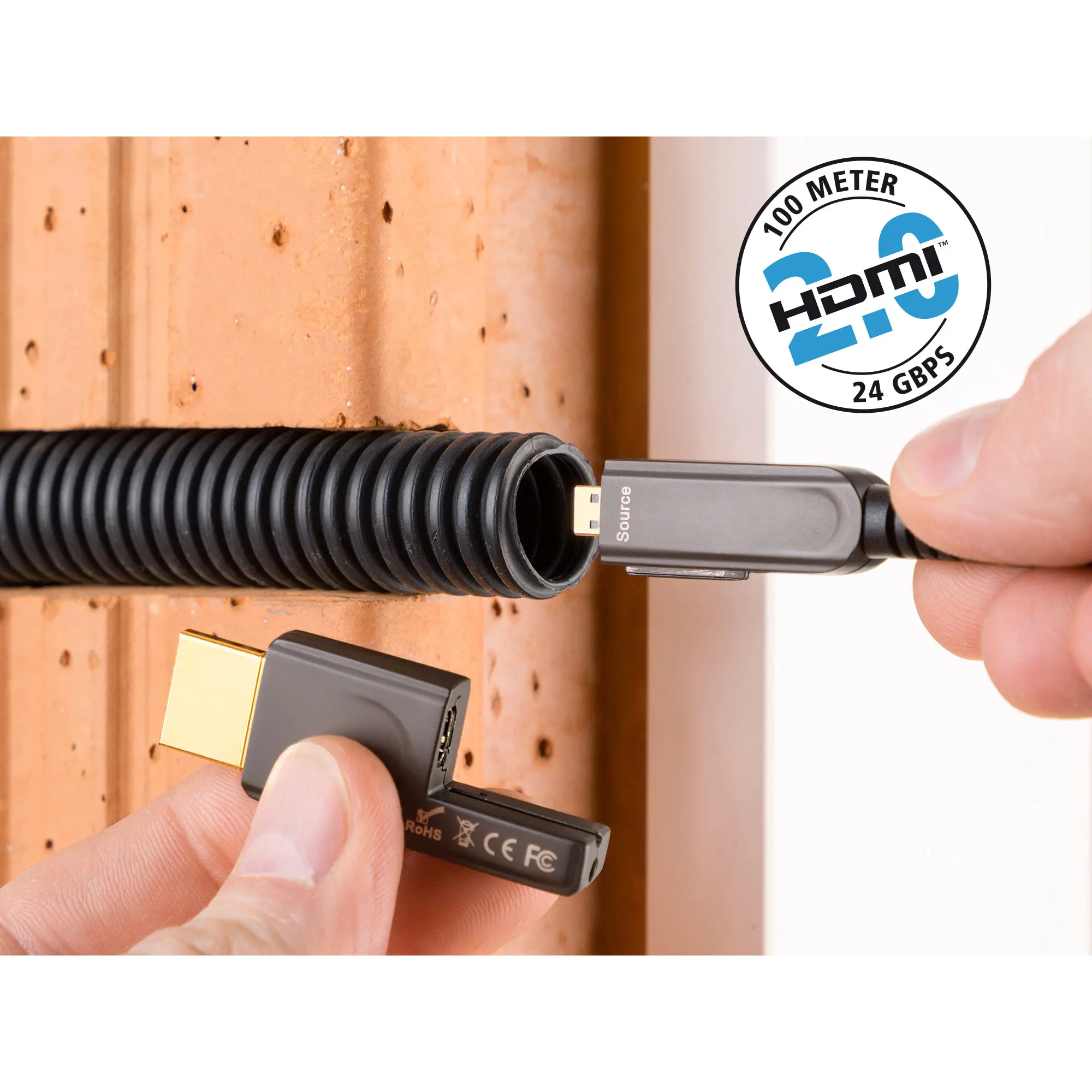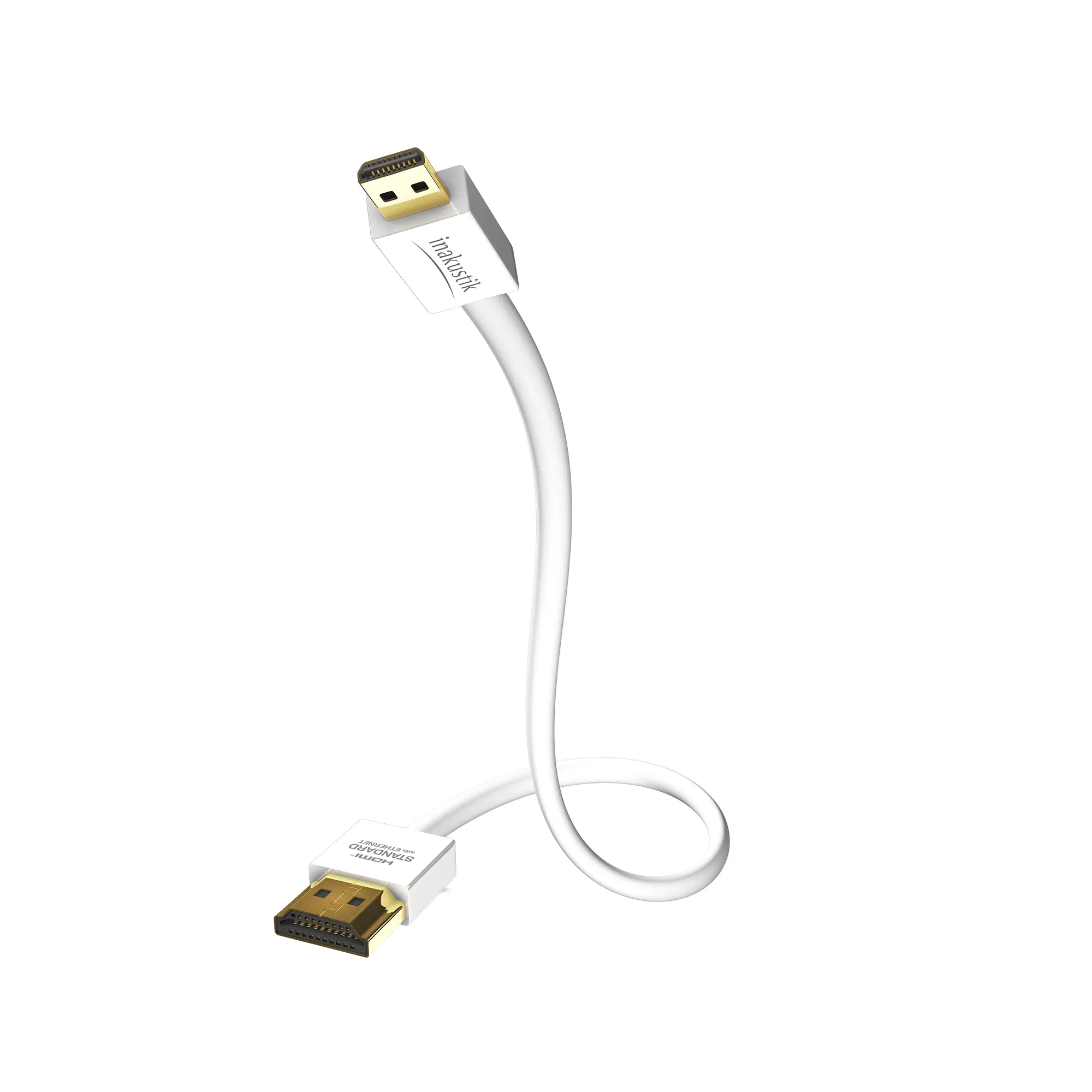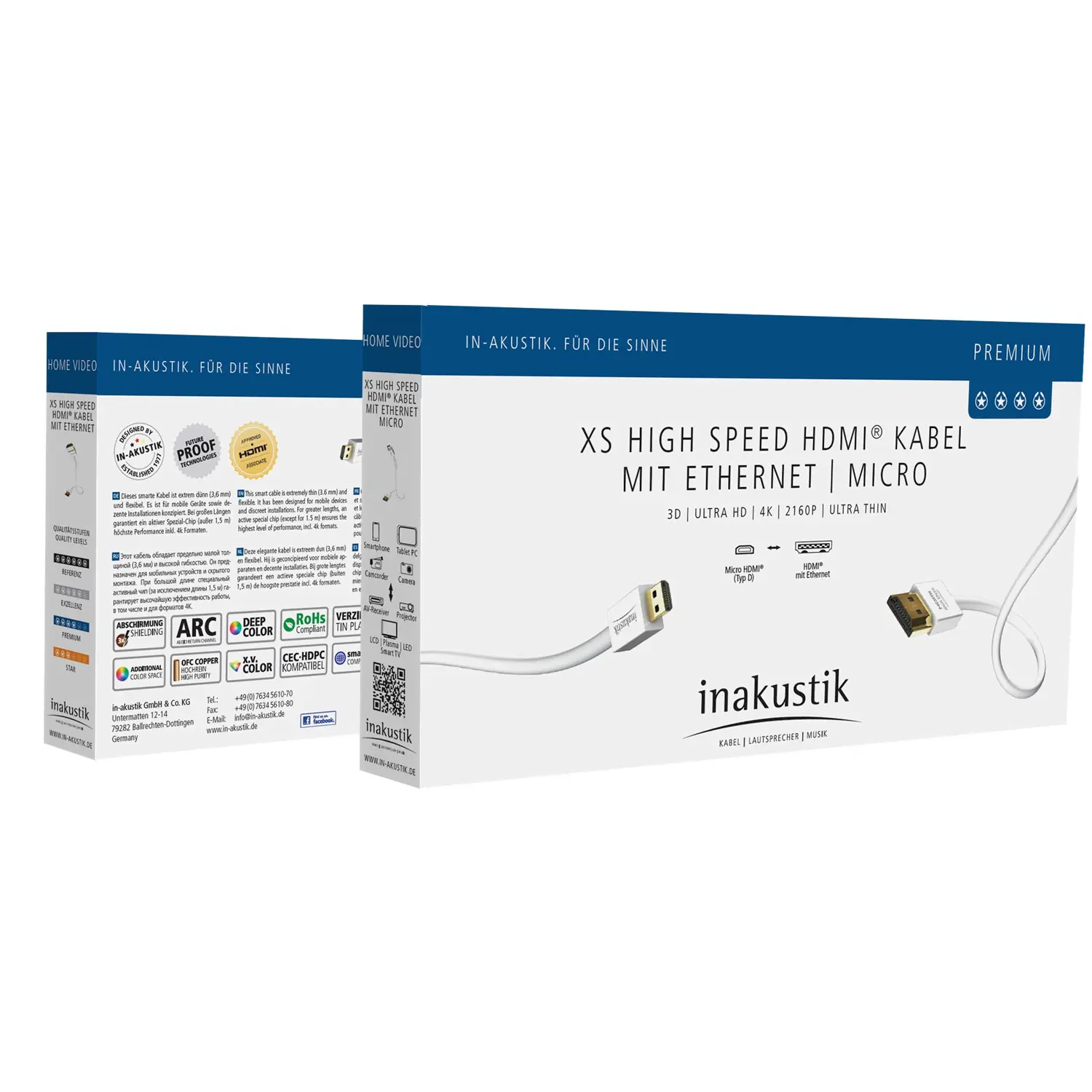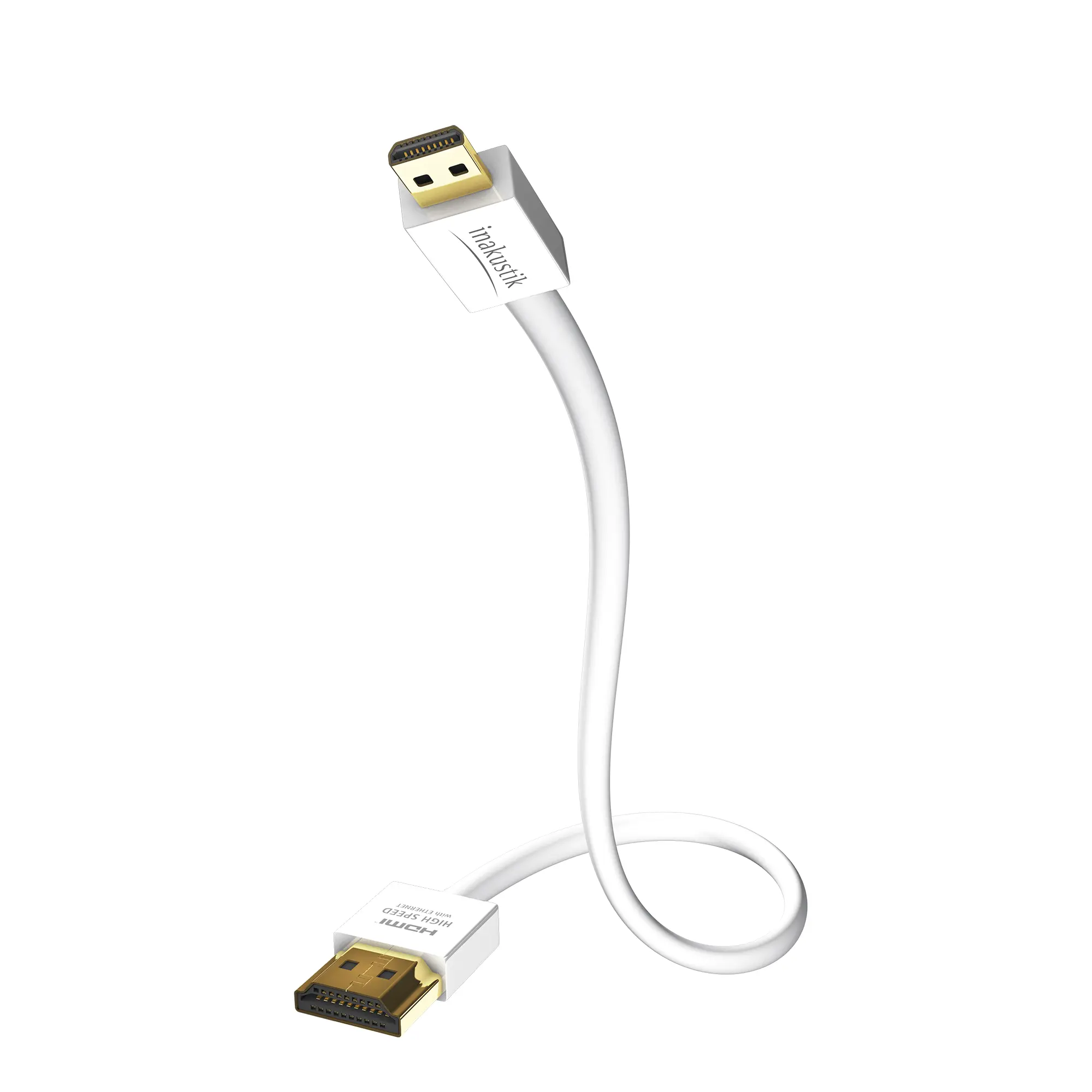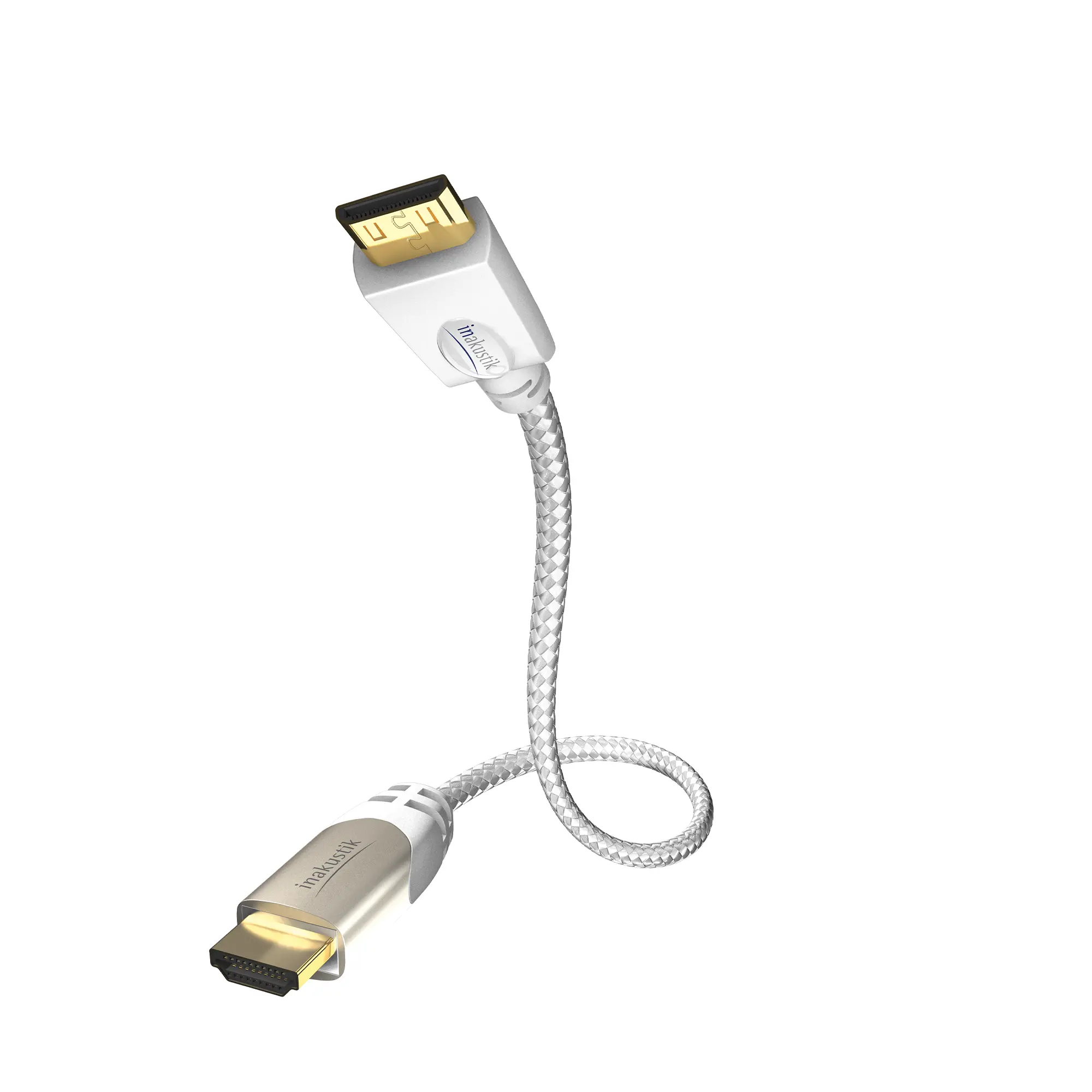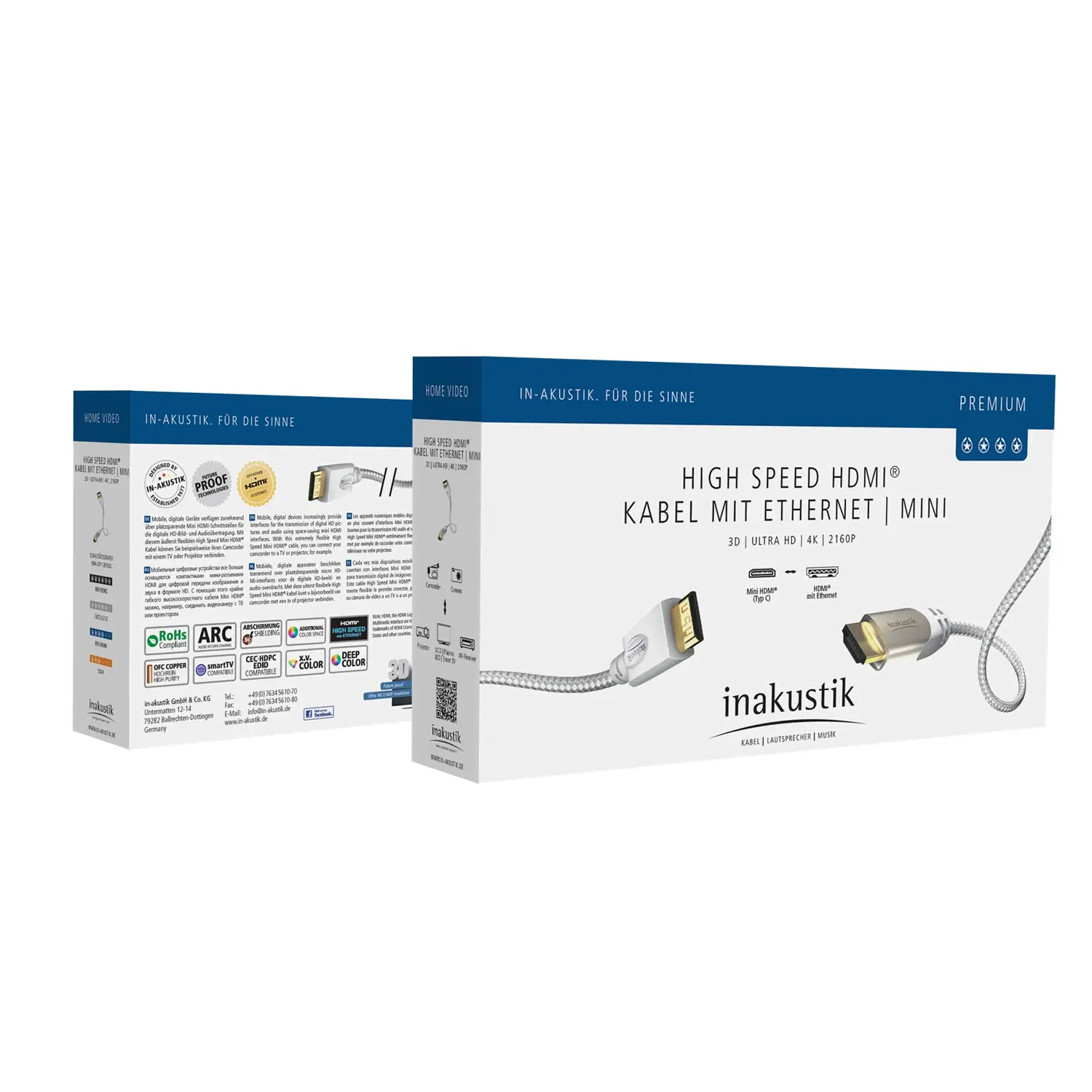Buy high-end HDMI cables: The ultimate experience for home cinema and gaming
HDMI: The standard for digital picture and sound
High Definition Multimedia Interface, abbreviated as HDMI, has been the undisputed standard for digital picture and sound transmission in entertainment electronics since 2002. Before HDMI, analog connections like SCART, Composite Video, and S-Video dominated, but they exhibited significant weaknesses in terms of picture and sound quality as well as compatibility.
HDMI revolutionized the home cinema world:
- Digital Transmission: Compared to analog connections, HDMI offers significantly higher picture and sound quality. The susceptible analog signal transmission is a thing of the past.
- One Cable for Everything: HDMI combines picture and sound signals into a single cable. Say goodbye to cable clutter behind the TV!
- Compact Connectors: HDMI connectors are much more compact and user-friendly than bulky SCART connectors.
- Device Versatility: HDMI is compatible with a vast array of devices, from TVs and Blu-ray players to gaming consoles like Microsoft's Xbox and Sony's PlayStation, as well as computers.
- HDMI has Rapidly Gained acceptance and is now indispensable in entertainment electronics.
- Future-proof: The latest version, HDMI 2.1a, brings you 8K resolution, 120 Hz refresh rate, and HDR for the ultimate experience.
The advantages of HDMI:
- Best Picture and Sound Quality: Supports high-resolution formats like 4K and 8K, as well as advanced audio formats like Dolby Atmos and DTS:X.
- Convenient Operation: Easy connection of devices with just one cable.
- Future-Proof: The HDMI specification is constantly evolving to meet new technologies and requirements.
- Versatile Applications: HDMI is not only suitable for home theater systems but also for computer monitors, projectors, digital cameras, and many other devices.
What is a high-end HDMI cable?
High-end HDMI cables go beyond standard requirements and offer improved performance and quality for transmitting audio and video signals. They are characterized by the following features:
- High-Quality Materials: High-end cables use oxygen-free copper (OFC), gold-plated connectors, and precisely crafted shields to minimize signal loss and interference.
- Higher Bandwidth: Supports higher resolutions (up to 8K) and refresh rates (up to 120 Hz) for smoother and more detailed images.
- HDR Support: Compatible with High Dynamic Range (HDR) for an extended color palette and higher contrast to create a more realistic picture.
- Compatibility with All HDMI Devices: Works with all devices equipped with an HDMI port, such as TVs, Blu-ray players, gaming consoles, and soundbars.
Why should you buy a high-end HDMI cable?
High-end HDMI cables offer many advantages over standard cables:
- Improved Picture Quality: Enjoy sharper images, vibrant colors, and deeper contrasts for the ultimate viewing experience.
- Optimal Audio Quality: Experience crystal-clear and noise-free sound for an immersive audio experience.
- Future-Proof Investment: High-end cables are compatible with the latest HDMI standards, making them ready for future upgrades.
- Durability: High-quality materials ensure long-lasting durability and reliable signal transmission.
What to consider when buying a high-end HDMI cable?
Consider the following factors when purchasing a high-end HDMI cable:
- Compatibility: Ensure the cable is compatible with your devices. Check the HDMI version and supported resolutions and refresh rates.
- Length: Choose the right cable length for your needs. Too short cables can cause strain, while too long cables can result in signal loss.
- Bandwidth: Look for the cable's supported bandwidth. For 8K resolution and HDR, you'll need a cable with at least 48 Gbps bandwidth.
- Connectors: Choose between standard HDMI connectors and HDMI connectors with strain relief.
Which HDMI version do I need?
The required HDMI version depends on your devices and your requirements.
In terms of resolution, consider the following when making a purchase:
For Full HD resolution, HDMI 1.3 is sufficient.
For 4K resolution at 60 Hz, you need at least HDMI 2.0.
For 8K resolution or 4K resolution with a 120 Hz refresh rate, HDMI 2.1 is required.
Overview of different HDMI versions
Not all HDMI versions are the same. Over the years, various versions of the standard have been released, differing in their capabilities and supported features. Here's a brief overview of the major HDMI versions:
HDMI 1.0 (2002)
- The first HDMI version supported resolutions up to 1080p (Full HD) and 60 Hz refresh rate.
- Integrated HDCP copy protection.
HDMI 1.1 (2004)
- Support for DVD-Audio and SACD.
HDMI 1.2 (2005)
- Support for Deep Color for 12-bit color depth.
- CEC (Consumer Electronics Control) for controlling devices with a single remote.
HDMI 1.3 (2006)
- Support for xvYCC color space.
- Dolby TrueHD and DTS-HD Master Audio.
HDMI 1.4 (2007)
- Support for 3D signals.
- Ethernet channel for data transmission.
- Audio Return Channel (ARC) for transmitting audio signals from the TV to an AV receiver.
HDMI 2.0 (2013)
- Support for 4K resolution (3840 x 2160) at 30 Hz refresh rate.
- Rec. 2020 color space.
- HDR (High Dynamic Range) for enhanced contrast and color dynamics.
HDMI 2.0a (2014)
- Support for 4K resolution at 60 Hz refresh rate.
- HDCP 2.2 copy protection.
HDMI 2.1 (2017)
- Support for 8K resolution (7680 x 4320) at 30 Hz refresh rate.
- 4K resolution at 120 Hz refresh rate.
- Dynamic HDR for dynamic adjustment of HDR metadata.
- eARC (Enhanced Audio Return Channel) for high-resolution audio formats like Dolby Atmos and DTS:X.
HDMI 2.1a (2022)
- Improved VRR (Variable Refresh Rate) for smoother gameplay.
- Enhanced CEC commands: Improved control of connected devices, such as automatic input switching.
- Source-Based tone mapping (SBTM) for optimized HDR display on different devices.
- Cable power delivery (CPD): CPD enables power delivery to compatible devices via the HDMI cable (up to 30 watts).
The various HDMI cables from in-akustik
Get Ready for the Future: Ultra High Speed HDMI Cables
If you've just purchased a brand new 8K TV or a cutting-edge gaming console with high-frame-rate gaming, then maximize the potential of your tech with an Ultra High Speed HDMI Cable!
To ensure the quality and compatibility of these cables, a certification program has been introduced.
Certification
Only HDMI cables that pass the stringent tests of the HDMI Forum receive the official Ultra High Speed certification. These tests include:
- Signal transmission: Secure transmission of high-resolution video and audio signals.
- Compatibility: Functionality with all HDMI devices supporting the Ultra High Speed specification.
- Interoperability: Seamless interaction with other certified cables and devices.
What is an ultra high speed HDMI cable?
Ultra high speed HDMI cables, also known as HDMI 2.1 cables, are the latest generation of HDMI cables. They have been specifically designed to meet the growing demands for picture quality, resolution, and refresh rates in consumer electronics.
What are the benefits of ultra high speed HDMI cables?
- Breathtaking picture quality: Enjoy razor-sharp images with 8K resolution (7680 x 4320 pixels) and smooth motion thanks to high refresh rates of up to 120 Hz.
- Lifelike colors and contrasts: Experience the world of High Dynamic Range (HDR) with expanded color gamut and higher contrast ratio for a more realistic viewing experience.
- Gaming without limits: Enjoy tear-free and lag-free gaming with Variable Refresh Rate (VRR). Say goodbye to screen tearing and input lag – dive deeper into the gaming experience!
- Future-proof: Ultra High Speed HDMI cables are backward compatible with older HDMI versions, ensuring you are well-prepared for future technologies.
- For 8K TVs and Next-Gen consoles: To fully utilize the resolution and refresh rate of your new devices, you need an Ultra High Speed HDMI cable.
- For gamers: For a smooth and responsive gaming experience with VRR, Ultra High Speed HDMI cables are the optimal choice.
- For HDR support: To enjoy the extended color and contrast capabilities of HDR, you need a compatible cable.
Buy standard HDMI to HDMI mini C connector
The HDMI cable with Standard HDMI to HDMI Mini C connector is a specialized connection cable designed to connect a variety of devices with different HDMI ports. This cable is particularly useful in the digital world where the transmission of high-definition audio and video signals between devices such as cameras, laptops, gaming consoles, and televisions is required.
The Standard HDMI end, also known as Type A, is the most commonly used HDMI plug and fits into most TVs and monitors on the market today. The HDMI Mini C connector, also known as Type C, is a smaller version of the Standard HDMI plug specifically designed for portable devices. It is commonly used in DSLR cameras, high-end video cameras, and some compact laptops.
Armored high-speed HDMI cable for tough conditions
With our extremely robust professional High-Speed HDMI cable, you can connect your devices over long distances with the highest quality.
This professional HDMI cable utilizes innovative fiber optic technology to transmit data rates of up to 24 Gbps over distances of up to 100 meters. The cable thus supports high-resolution 4K formats at 50 or 60 Hz, 4:4:4 color sampling, as well as HDR, and is the perfect solution for connecting devices with HDMI 2.0b interfaces over long distances.
Thanks to its solid armor made of a steel helix and Kevlar threads, the cable is extremely resistant and can withstand tensile loads of up to 100 kg, and even up to 200 kg for short periods. The full-metal connectors are protected during transport and assembly/dismantling by a plastic sleeve with a screw cap.
Standard HDMI to HDMI micro D | Active cable
Our Standard HDMI < > HDMI Micro D | Active Cable is a connection cable that connects two devices with HDMI ports. It has a Standard HDMI plug (Type A) at one end and a Micro HDMI plug (Type D) at the other end.
Standard HDMI plug:
- Type A: The most common HDMI plug type.
- 19 pins: Rectangular shape with 19 contacts.
- Connections: Mostly found on TVs, Blu-ray players, gaming consoles, and computers.
Micro HDMI plug:
- Type D: Smaller plug type compared to Standard HDMI.
- 19 pins: Also 19 contacts, but arranged differently.
- Connections: Commonly found on compact devices like digital cameras, camcorders, tablets, and certain laptops.
Buy high-speed HDMI cable with ethernet channel
This type of cable offers the same basic performance as a regular High-Speed HDMI cable but additionally features a dedicated data channel known as HDMI Ethernet Channel, which can interconnect devices. However, the HDMI Ethernet Channel functionality is only available when both connected devices are HDMI Ethernet Channel-enabled.
Regular high-speed HDMI cable:
- Suitable for transmitting high-definition video and audio signals.
- Supports common resolutions like 1080p and 4K at lower refresh rates.
High-speed HDMI cable with ethernet (HDMI Ethernet Channel):
- Provides all the features of a regular High-Speed HDMI cable.
- Includes an additional dedicated data channel called HDMI Ethernet Channel (HEC).
- This HEC enables device networking between two compatible HDMI devices.


